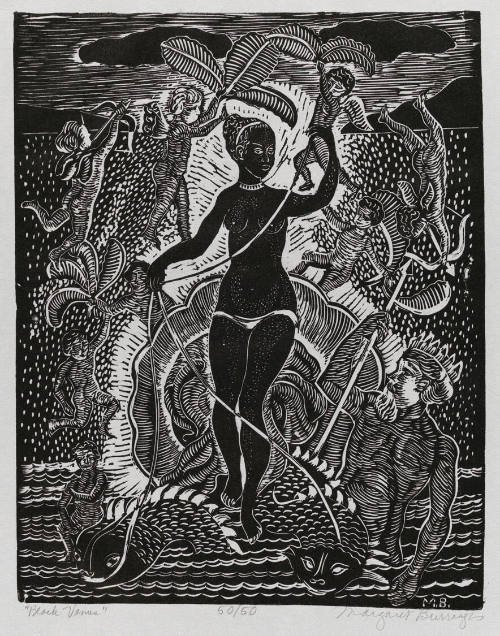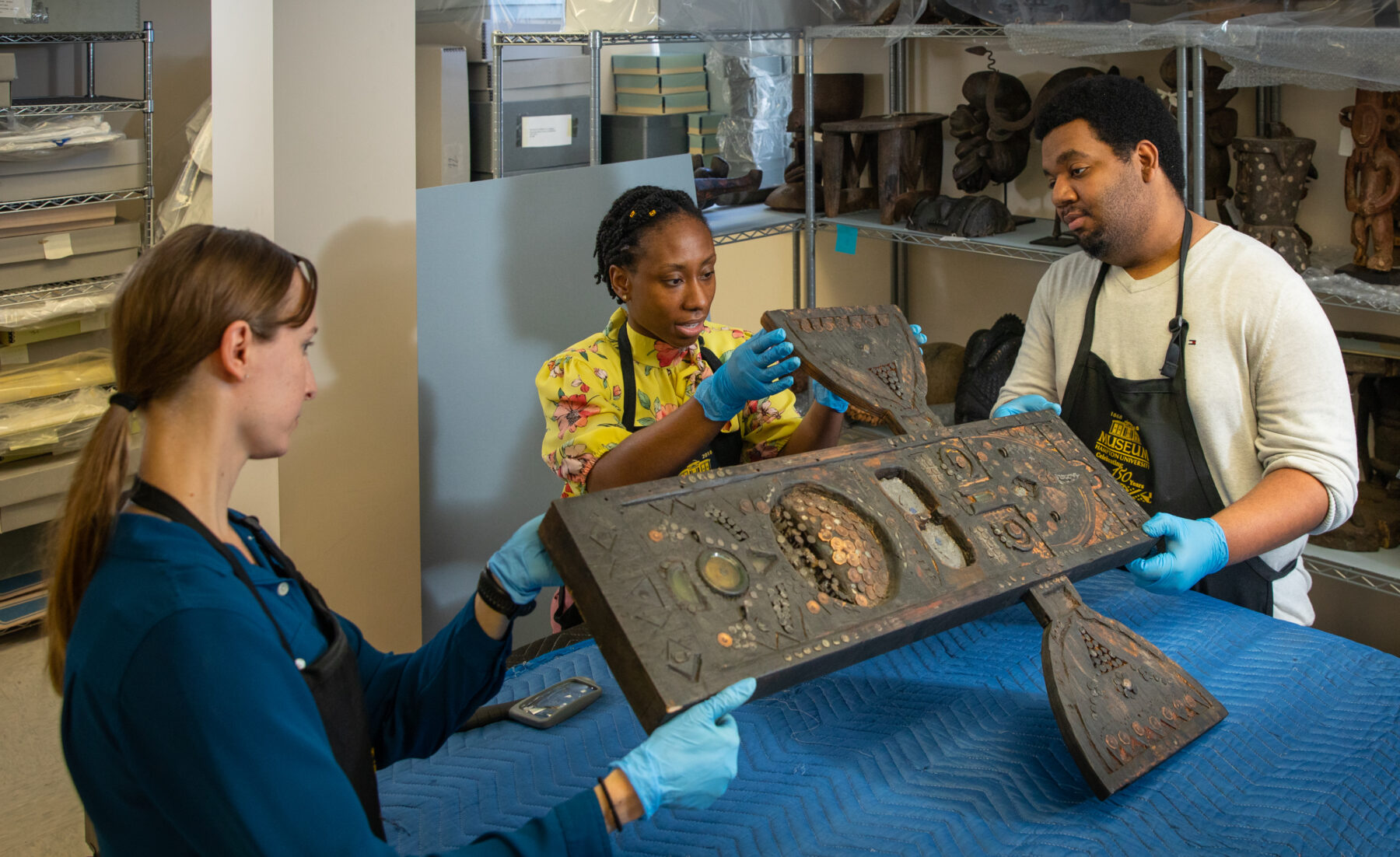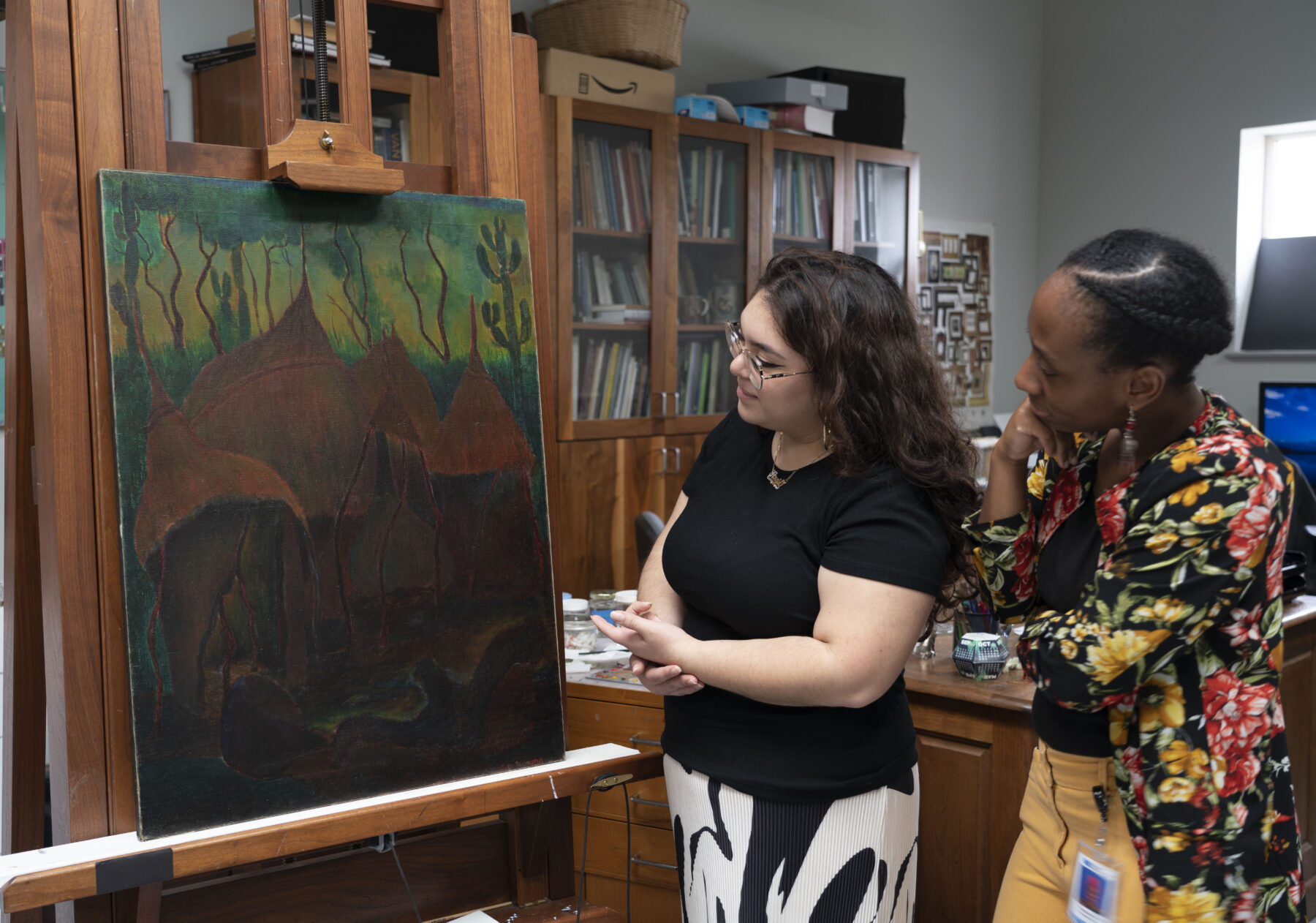Consolidating Miranda “Olayinka” Burney-Nicol’s Night Dancer


Journey to the Chrysler

Hello! I am Angie Lopez, the Andrew W. Mellon Conservation Fellow. I began my fellowship at the Chrysler Museum of Art in partnership with the Hampton University Museum in August 2023. I am excited to share my journey into the field of art conservation and my current work on the Harmon Foundation Modern African Art Collection.
I grew up in Bergen County, New Jersey, just outside New York City. Living close to the city meant I frequently visited NYC for field trips. A trip to the Metropolitan Museum of Art for an art class ignited my passion for art history. My professor noticed my interest and recommended I look into the University of Delaware’s (UD) art conservation program. Taking his advice to heart, I embarked on my journey in art conservation. At UD, I pursued a double major in Art Conservation and Art History with a minor in Latin and Iberian Studies. I gained invaluable experience through conservation internships and jobs, including positions at Winterthur Museum and the Maryland Center for History and Culture. Following graduation from UD in May 2023, I began a summer monuments conservation internship in New York City’s Central Park. I worked on the park’s extensive collection of bronze sculptures, removed graffiti, maintained fountains, and acquired masonry skills. After an educational and action-packed summer, I packed my bags and headed to Norfolk, Virginia, where I joined the team at the Chrysler Museum of Art and the Hampton University Museum.
Examination of Night Dancer
After becoming oriented to the partner institutions and acquainted with the team working on this project, I began examining my first painting Night Dancer by Miranda “Olayinka” Burney-Nicol (1926-1996, Sierra Leone). The painting depicts a multicolored masquerader in a forest, one of the artist’s many visual themes. Olayinka belonged to the first generation of African artists who did not follow indigenous art practices. After teaching for a year in Sierra Leone, she won a scholarship to study arts and humanities in New York City. She then studied in a London art school, meeting with artists and experiencing European art in person. Olayinka returned to Sierra Leone in 1958 and served as a government artist for ten years, developing visual arts and producing murals for the government. Although her images were generally drawn from Sierra Leone, she also drew inspiration from Mexico, China, and Egypt, fusing these cultures with her own.
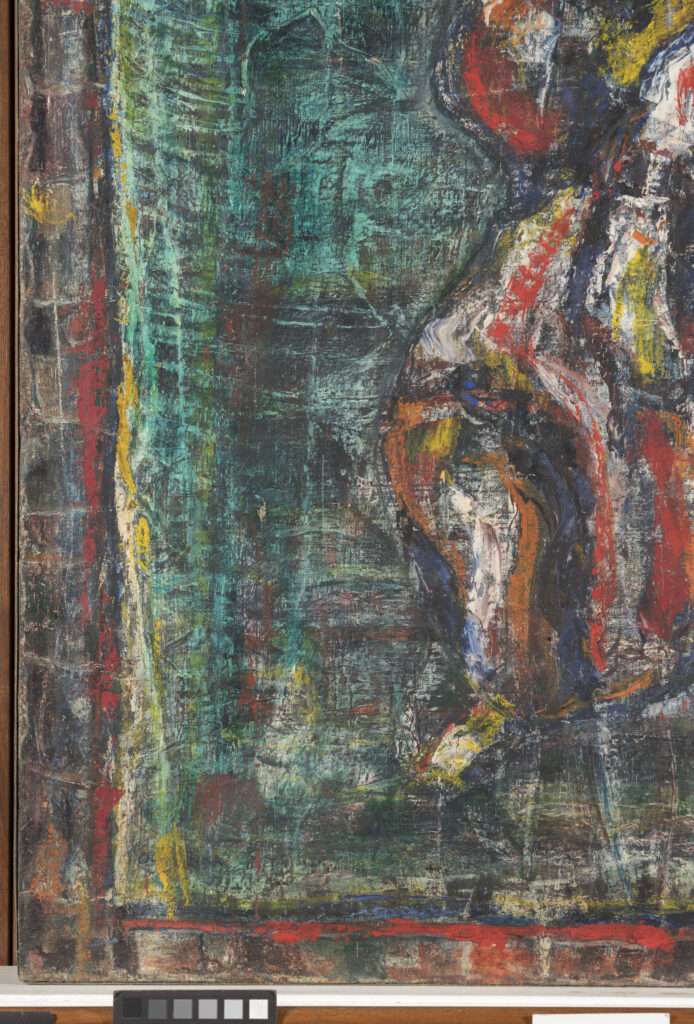
What I found to be the most interesting when examining this painting was the artist’s technique. Olayinka seemed to have scored the surface while the paint was still wet, creating a pattern on the bottom left side of the painting. She also seemed to have painted wet paint into wet paint, allowing her colors to blend on the canvas. Moderate impasto was created by thickly layering paint, particularly on the dancer. She also used light, thin washes of color, particularly in the light green areas on the left side of the painting. Interestingly, she had partially obscured her signature with a swipe of yellow paint.
Condition

Initially, looking at Night Dancer, it was easy to get distracted by the canvas’s distortions and slackness. When examining the structure of the painting, it was noted that the canvas was attached very loosely to its stretcher. This lack of sufficient tension meant the paint layer could not be adequately supported. As a canvas ages, it loses strength and stiffness due to prolonged tension. This tension causes the fibers of the canvas to elongate, leading the canvas to slack. The paint and ground may become the stiffest part of the painting structure and become self-supporting. In the case of Night Dancer, the artist’s uneven paint application likely caused the distortions, as the thick areas of paint may be causing particular areas to have unexpected tension.
Additionally, a half-inch tear was present at the bottom edge of the painting. Upon close inspection, several small areas of abrasion, loss, and lifting paint could be seen. The cracking and flaking paint is likely due to Olayinka’s layering multiple paint applications with varying oil paint medium content and scribing into the surface.
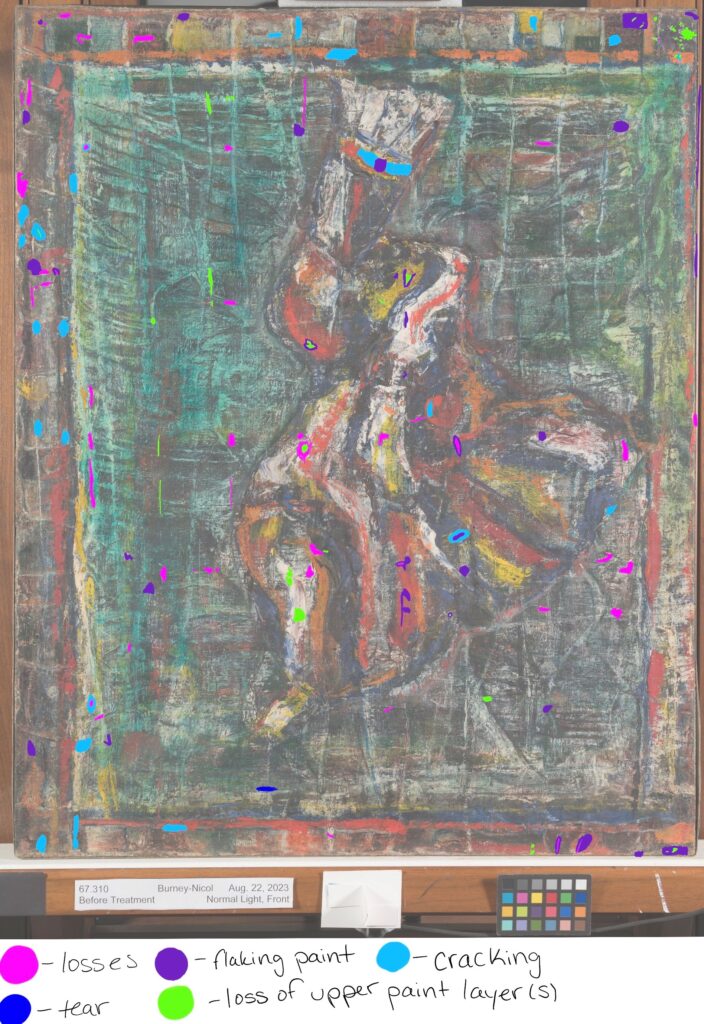
Consolidation
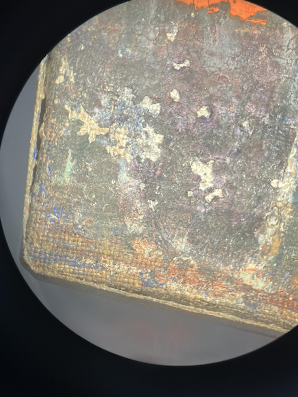
After a thorough examination, solvents of varying polarities were tested on the different colors of the painting using tiny swabs to find a solvent that would not react with the paint. These tests were conducted under an optivisor, allowing small changes to be observed. After the solvent test, it was determined that isinglass or sturgeon glue would be an appropriate consolidant. Sturgeon glue is a protein glue made from the bladder of the sturgeon fish traditionally used by Russian conservators. This glue has a greater tack and lower viscosity than other animal glues, such as gelatin and rabbit-skin glue, allowing it to easily wick into cracks and losses. Due to these properties, it was decided that sturgeon glue diluted in water would be the most effective consolidation method. Using the condition map I had created during the initial examination, I consolidated flaking areas using a small brush under a stereomicroscope. When encountering curled-up or lifting paint chips that could not be fully consolidated with the brush, I used a small sheet of silicone-coated Mylar and a small heated iron to gently relax the paint and allow it to lay back onto the canvas. Once this step is finished, I can begin dry-cleaning the painting. This will be done using a special HEPA vacuum with low suction, soft brushes, and cosmetic sponges.
Looking ahead, I am excited about the work we have in store as we continue to conserve Hampton’s Harmon Foundation Modern African Art Collection. It’s a true honor to work alongside Tashae Smith and the entire team, contributing to groundbreaking exhibitions and preserving the rich cultural heritage of these remarkable pieces. Thank you for joining me on this journey, and I look forward to sharing more updates about this exciting project in the future.
References
Resources / References
Alba, Ana. “Step by Step: How to make glue from fish bladders — ALBA ART CONSERVATION.” ALBA ART CONSERVATION, 4 September 2015, https://www.albaconservation.com/blog/2015/9/3/step-by-step-how-to-make-glue-from-fish-bladders. Accessed 26 September 2023.
Hartin, Debra Daly, and Wendy Baker. “Keying Out of Paintings – Canadian Conservation Institute (CCI) Notes 10/9.” Canada.ca, 30 July 2019, https://www.canada.ca/en/conservation-institute/services/conservation-preservation-publications/canadian-conservation-institute-notes/keying-out-paintings.html. Accessed 28 September 2023.
Ottenberg, Simon. Olayinka: A Woman’s View: The Life of an American Modern Artist. Africa World Press, Inc., 2013, https://www.amazon.com/Olayinka-Womans-African-Modern-Artist/dp/1592218326. Accessed September 25 2023.
Petukhova, Tatyana, and Stephen D. Bonadies. “Sturgeon Glue for Painting Consolidation in Russia.” Journal for the American Institute of Conservation, American Institute for Conservation of Historic and Artistic Works, 1993, https://cool.culturalheritage.org/jaic/articles/jaic32-01-003_indx.html. Accessed 25 September 2023.
Explore other articles like this
Diving into the Waters of The Black Venus
In her 1957 linoleum print, "Black Venus," Margaret Burroughs reimagines historical depictions of Black women, transforming narratives of exploitation into ones of resilience and empowerment. Her work challenges past portrayals and honors the Black female form.
The Andrew W. Mellon Fellowship: Now and Beyond
In this post, I will highlight some of the accomplishments of this project and address two main takeaways that can help those looking to reproduce a similar fellowship program.
Art Spotlight: The Abandoned Hut by Mordecai Buluma
In this blog post Angie and Tashae discuss the symbolism behind The Abandoned Hut by Mordecai Buluma as well as the conservation treatment used to prepare it for exhibition.
